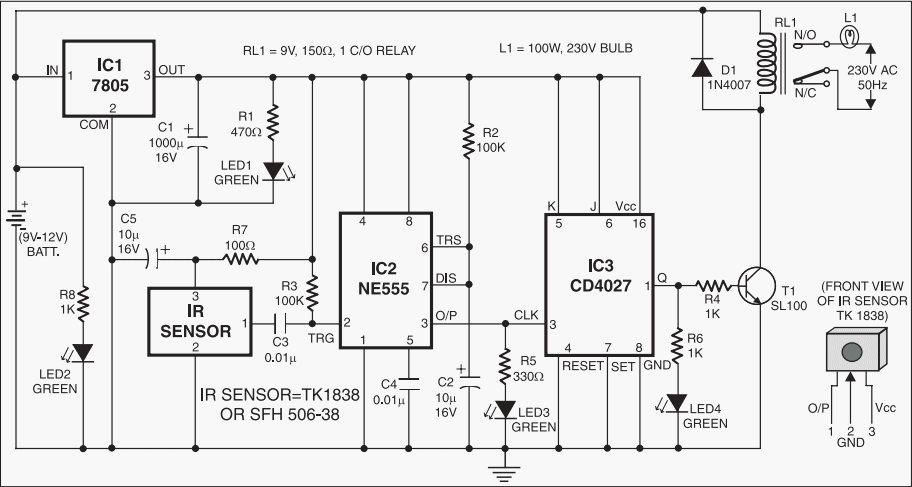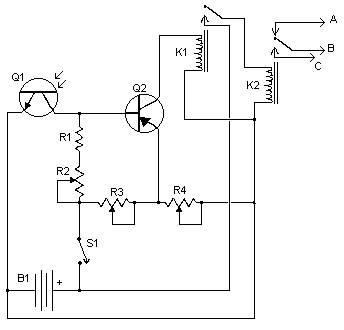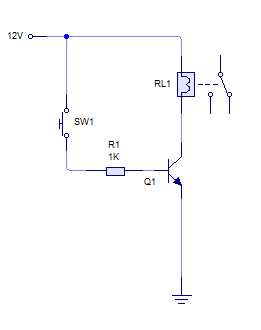
Under-Temperature Switch

The reference current is supplied from the supply voltage through resistor R1 to the inverting terminal, while the variable (non-inverting) current is sourced from the junction of resistors R3 and R4. Since the value of R1 is approximately double that of R2, it generates a current that is proportional to the supply voltage. Consequently, the trip temperature, which is set using R3, remains independent of the supply voltage.
In this circuit configuration, the primary function is to establish a reference current that is stable and accurately reflects the supply voltage. Resistor R1 is critical as it sets the reference level for the inverting terminal of the operational amplifier (op-amp). The inverting terminal receives this reference current, which is essential for the proper functioning of the feedback loop.
The variable current, derived from the junction of R3 and R4, serves to adjust the output of the op-amp based on the desired trip temperature. R3 and R4 form a voltage divider, allowing for fine-tuning of the input to the non-inverting terminal. The relationship between R1, R2, R3, and R4 ensures that the circuit can maintain a consistent trip temperature regardless of fluctuations in the supply voltage. This characteristic is particularly important in applications where temperature stability is critical, such as in temperature sensing or thermal management systems.
The ratio of R1 to R2 plays a significant role in determining the gain of the circuit. By ensuring that R1 is approximately double R2, the design achieves a gain that appropriately scales the reference current to match the operational requirements of the circuit. The op-amp will then compare this scaled current against the variable current from the divider, leading to a reliable output that can trigger further actions, such as activating a cooling system or an alarm when the trip temperature is reached.
Overall, this circuit exemplifies a robust design that leverages the properties of resistors and op-amps to achieve a stable and reliable temperature monitoring system, ensuring that the trip temperature remains constant despite variations in supply voltage. The reference current is fed from the supply voltage via Rl, to the inverting terminal, and the variable (noninver ting) current is supplied from the junction of R3 and R4. Because the value of Ri is approximately double that of R2, and generates a current that is proportional to the supply voltage, the trip temperature (preset via R3) is independent of the supply voltage.
In this circuit configuration, the primary function is to establish a reference current that is stable and accurately reflects the supply voltage. Resistor R1 is critical as it sets the reference level for the inverting terminal of the operational amplifier (op-amp). The inverting terminal receives this reference current, which is essential for the proper functioning of the feedback loop.
The variable current, derived from the junction of R3 and R4, serves to adjust the output of the op-amp based on the desired trip temperature. R3 and R4 form a voltage divider, allowing for fine-tuning of the input to the non-inverting terminal. The relationship between R1, R2, R3, and R4 ensures that the circuit can maintain a consistent trip temperature regardless of fluctuations in the supply voltage. This characteristic is particularly important in applications where temperature stability is critical, such as in temperature sensing or thermal management systems.
The ratio of R1 to R2 plays a significant role in determining the gain of the circuit. By ensuring that R1 is approximately double R2, the design achieves a gain that appropriately scales the reference current to match the operational requirements of the circuit. The op-amp will then compare this scaled current against the variable current from the divider, leading to a reliable output that can trigger further actions, such as activating a cooling system or an alarm when the trip temperature is reached.
Overall, this circuit exemplifies a robust design that leverages the properties of resistors and op-amps to achieve a stable and reliable temperature monitoring system, ensuring that the trip temperature remains constant despite variations in supply voltage. The reference current is fed from the supply voltage via Rl, to the inverting terminal, and the variable (noninver ting) current is supplied from the junction of R3 and R4. Because the value of Ri is approximately double that of R2, and generates a current that is proportional to the supply voltage, the trip temperature (preset via R3) is independent of the supply voltage.





